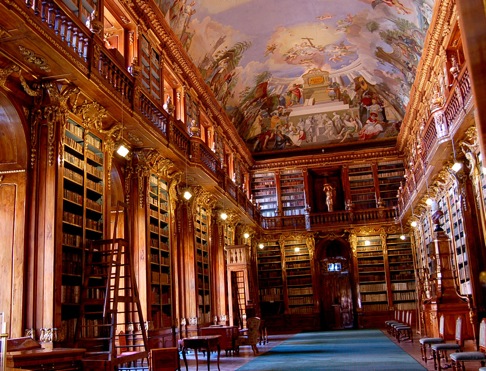
Thursday, December 25, 2008
Happy Holidays

Wednesday, December 17, 2008
Airports: home sweet home?

This story can lead to interesting conversations with your students if you raise questions like:
Are there similar cases to this one in your own countries?
Please feel free to write any comments about similar stories to this in your countries.
Sunday, November 23, 2008
Online Guided Tours
Monday, November 10, 2008
The responsible tourism movement in Ireland
Local Inhabitants and sustainability enthusiasts alike have sought to create tourist attractions which emphasise the natural, social and cultural heritages of the locality, whilst using sustainable means of generating energy (solar panels, wind power, ancient methods) and providing food (local farms) and other essentials (bio-degradable soap, local ales) to their guests.
Accommodation provisions, ranging from Bed & Breakfast to self catering eco cabins, combined with optional training courses, from “Learning traditional skills” to “Sustainable living”, offer potential tourists plenty of opportunities to practice sustainable tourism on the Emerald Island. What’s more, all these ecologically sound ventures are easily accessible to all ages, offer educational opportunities which can help enhance the awareness towards sustainable living and ultimately may even contribute to changing priorities towards a more environmentally sound approach to living.
The works of organisations such as An Taisce (http://www.blogger.com/www.antaisce.org/) and Greenbox (http://www.greenbox.ie/) have laid great emphasis on the environmental benefits that ST can have for rural Ireland, but their efforts have highlighted the economic benefits of sustainable tourism so that these have increasingly been taken into consideration when planning future projects.
Following the extreme economic development of Ireland in recent years, as a result of European Community investment, it has been suggested it would be possible to move resources to remote areas of Ireland, and, by investment in sustainable tourism, create a sustainable economy in the most impoverished communities (Tomasella, B. 2008).There are many projects which could be branded as Responsible Tourism. Their focus is on empowering communities and bringing economic benefits to local areas, as well as caring for the environment and traditional activities. Many of these projects are only just starting and are struggling to take off because of their remoteness and lack of means for promotion.
THE CELT (http://www.celtnet.org/- Environmental courses and holidays), Gaelic Ways (http://www.gaeltacht.eu/ - Accommodation and showcase of traditional farming ways, for Gaelic speaking tourists) and Kerry Geo-park (http://www.sccird.com/geopark/resources/geopark1.htm - a Geo-park which promotes cultural festivals and local activities for an otherwise very poor area of Ireland) are but a few of these projects. This lack of resources results in problems being experienced by genuine projects focusing on ST and RT, and has brought about the creation of an organisation called Sustainable Tourism Ireland (http://www.blogger.com/www.sustourism.ie). The people involved, members of the Cultivate Centre based in Dublin (http://www.cultivate.ie/), decided to start an affiliate organisation that focuses on Sustainable Tourism. Its aim is to contribute to ST in Ireland, by raising its profile amongst tour operators and tourists.
Barbara Tomasella, project co-ordinator for Sustainable Tourism Ireland has great aspirations for the organisation: “In 5 years we would like to see ourselves as a cultural centre giving courses and talks about Sustainable Tourism, as well as offering consultancy and marketing services to small tour operators, looking to find their place in the Responsible/Sustainable Tourism market.” she said“We believe that Sustainable Tourism can definitely be a way to sustaining Irish heritage in the long term. One might be sceptical about it, saying that it is impossible for ST to take off considering that the Irish government's record on ecotourism and ecology is very minimal. But there are a lot of things changing, see for example the renewed interest from Failte Ireland (http://www.failteireland.ie/ - National Tourism Development Authority) towards Sustainable Tourism”
Please contact Barbara Tomasella (barbara@sustourism.ie) for more information or visit http://www.sustourism.ie/ and http://www.cultivate.ie/.
West Africa Travel Market - MBOKA 2008

Recently, new initiatives have been seeking to promote a responsible/sustainable form
The West African Travel Market (WATM) is one of these initiatives, and, as quoted in their brochure, aims to facilitate the co-operation between tourism businesses from West Africa and the European travel trade. It acts as an open platform where local businesses and communities, international tour operators, investors, NGO’s and governments can meet to support a sustainable development of the tourism sector in West Africa.
The WATM is established as a permanent initiative offering an integrated set of instruments and actions such as an online market event, international marketing support and an annual West African Travel Market Business-to-Business event.
Examples of the type of projects that this initiative aims to support can increasingly be found across West Africa. The Tiwai Island wildlife sanctuary is one of them. Situated on an island in the Moa river in Sierra Leone, this venture is located in an area with one of the highest density of primates in the world, and is home to endangered chimpanzees. The park offers a unique experience to discover the rich flora and fauna of the rainforest through forest trekking, wildlife watching and boat tours. The sanctuary is a community conservation programme, managed by the Island Administrative Committee, which represents both communities, government, universities & conservation organizations. All funds raised go towards the further protection of the park as well as supporting the Community Development Fund.
This year, the WATM, MBOKA 2008 was held in Banjul, The Gambia, and hosted a large turn out of a wide range of stakeholders such as:
• European tour operators searching for new and sustainable tourism products
• Sustainable products looking for market access
• Hotels and destinations interested to become more sustainable
• Governments looking for exchange of experiences and success stories
• Promotion agencies searching for partnerships
• Development agencies identifying new approaches and promising initiatives
• Private investors looking for opportunities and inspiration
So if you are interested in participating in the next West African Travel Market, don’t hesitate to visit http://www.westafricantravelmarket.com/ for updated information on sustainable products, to meet with international tour operators, or to register for the next MBOKA West African Travel Market.
Sunday, November 9, 2008
A matter of pronunciation
Sunday, October 26, 2008
CVs and Covering Letters
So as not to go wrong here are some tips about writing a CV and a covering letter. As usual any comments are more than welcome.
Sunday, October 12, 2008
Afraid of phonetics?
What you should know when travelling in Europe
Sunday, September 21, 2008
The 100 top tourist destinations
Saturday, September 13, 2008
Tipping or not tipping that is the question
Tipping or not tipping that is the question. Many tourists that travel to other countries are not aware of the different tipping customs existing in different countries. So it is very important to get acquainted with those customs so that you can advise tourists wisely and avoid any uncomfortable situation. Please if you read the following presentation and you would like to comment on anything, write to me at maochoa35@gmail.com. Any comment is welcome.
Thursday, August 28, 2008
Scenic Train Rides Around The World
by Steve Gillman
I'm not sure why on scenic train rides you can have a beer, but you can't on a bus. In any case, this is one of the reasons to take a train ride. Another reason is that they go where the roads don't, so you'll see scenery you miss when driving. Trains don't have to stop at traffic lights, and you can get up and walk around. Finally, trains are relaxing for all the reasons above AND the rythym of the rails.
Amtrak has scenic sections, and there are also numerous dinner trains operating around the United States now. However, the most scenic train rides are the classics. Below are a few to whet your appetite.
The Silverton-Durango Narrow Gage
I first caught this train far from any road. I was in the Weminuche Wilderness Area, next to a footbridge over the Animas river, where they stop if backpackers there flag them down. More recently, my wife and I took the train from Silverton to Durango. Wherever you catch this train, it will be an experience you won't forget.
It is a classic steam locomotive that goes through Colorado's San Juan Mountains, along the Animas river. At times you'll look out the window, over the edge, to the water hundreds of feet below. In Silverton you can eat good food, buy souvenirs, and see an old-west mining town that hasn't much with time.
La Nariz Del Diablo
photo by Wikipedia
Train rides on this line, which goes from Riobamba to Alausi, Ecuador, are scenic and adventurous. On our recent trip, my wife stayed inside, but I rode on the roof for the first half of the ride. Despite the occasional rain, there were twenty other travelers up there. I highly recommend you pay the dollar to rent a pillow to sit on. Your final destination is a valley with a view of a rock formation high above, called "La Nariz Del Diablo," or "The Devil's Nose."
Be careful of tree branches if you're on the roof, and be prepared for a five-hour ride. It starts in downtown Riobamba, in the highlands of the central Andes Mountains. You'll travel through "cloud forests" and finally down to a much warmer climate. Interestingly, the train descends some streches of track caboose-first. There's a lunch stop in one of the small mountain towns. When we took the train (May 2004), it was limited to 40 passengers, and tickets sold out quickly.
Agawa Canyon Railroad
photo by Tripadvisor
One of the more scenic train rides in the north, starts and ends in Sault Saint Marie, Ontario, Canada, just over the border from Sault Saint Marie, Michigan. It's an all-day trip that goes through a rocky and heavily-wooded wilderness, along the Agawa River, to Agawa Canyon. At the canyon, you can have a picnic in a beautiful meadow, or just relax and enjoy the scenery, before reboarding for the return trip.
Autumn, when the maples have all changed color, is the most beautiful time to take the train. It's also the most difficult time to get tickets, so plan far ahead. The route is also run as the scenic "Snow Train," in winter.
The Thunder Mountain Line
Thunder Mountain Line has scenic train rides that take several routes in Idaho, starting from Horseshoe Bend and Cascade. Depending on the route you choose, you'll travel through dramatic narrow canyons, sagebrush-covered hills, mountain meadows, or pristine evergreen forests. The tracks follow the mountain trails settlers used a hundred years before. You may see deer, fox, elk, blue herons, osprey, and bald eagles. Rides vary from three to five hours, depending on the route.
Amtrak's Scenic Train Rides
The California Zephyr, Amtrak's train from Chicago to San Francisco, passes through the Rocky Mountains and the more beautiful (in my opinion) Sierra Nevadas. The Coast Starlight goes from Seattle to Los Angeles, with views of snow-covered mountains, thick forests, and long stretches of Pacific Ocean shoreline. Amtrak's Auto Train is a unique scenic train ride that allows you to take your car with you from Lorton, Viginia, to Florida.
Steve Gillman hit the road at sixteen, and traveled the U.S. and Mexico alone at 17. Now 40, he travels with his wife Ana, whom he met in Ecuador. To read their stories, tips and travel information, visit: http://www.EverythingAboutTravel.com
Friday, August 1, 2008
Beijing - City of Wonder
Beijing - City of Wonder
By Kaye Madsen
Photos by Rick & Kaye Madsen
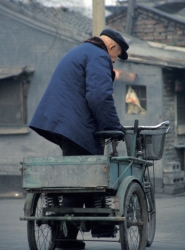 Even as a child I was drawn to exotic destinations! By the time I was eight I had studied the photographs in my grandparent's series of Stoddard's Lectures and knew that one-day I must see these wonders for myself. Now the day was at hand. The thrill of anticipation raced through my mind as my flight entered the final approach to Beijing. I would have eight days of adventure exploring her nooks and crannies.
Even as a child I was drawn to exotic destinations! By the time I was eight I had studied the photographs in my grandparent's series of Stoddard's Lectures and knew that one-day I must see these wonders for myself. Now the day was at hand. The thrill of anticipation raced through my mind as my flight entered the final approach to Beijing. I would have eight days of adventure exploring her nooks and crannies. We arrived in the evening at the recently opened international airport, which was so sleek, and modern that it bore no resemblance to the China I'd envisioned. I quickly realized that China is a country of sharp contrasts and that Beijing reflects the many facets of its culture.
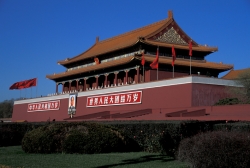 Our first day dawned bright and clear with a brilliant blue sky which contrasted vividly with the red of Tian'anmen gate. We spent the morning walking around the square, observing the great landmarks of modern China, which included the Great Hall of the People, the Chairman Mao Memorial Hall and the Monument to the People's Heroes. On our first two days of sight seeing we toured with a group of twelve guided by, Jack, (all Chinese guides seem to have adopted western names). He enthusiastically briefed us on the significance of each building.
Our first day dawned bright and clear with a brilliant blue sky which contrasted vividly with the red of Tian'anmen gate. We spent the morning walking around the square, observing the great landmarks of modern China, which included the Great Hall of the People, the Chairman Mao Memorial Hall and the Monument to the People's Heroes. On our first two days of sight seeing we toured with a group of twelve guided by, Jack, (all Chinese guides seem to have adopted western names). He enthusiastically briefed us on the significance of each building.
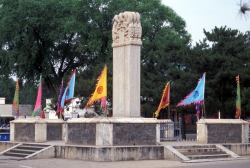 In the afternoon we visited the Forbidden City or Palace Museum as it is now called. It was declared a World Heritage Site in 1987 and has undergone extensive restorations since then. Home to the Ming and Qing dynasties from 1420 to 1911, it is an incredible complex consisting of 9,999 rooms built by over a million workers and over 100,000 craftsmen. Jack explained the symbolic significance in each phase of the architecture, in the numbers of steps, in the colours used for decorating, in the animal statues on the grounds, and in the direction which rooms and gates face. I was awed by the beauty and harmony of the palace and could imagine it bustling with activity many long years ago. It is impressive even without furnishings and treasures, which were moved to Taiwan in 1949.
In the afternoon we visited the Forbidden City or Palace Museum as it is now called. It was declared a World Heritage Site in 1987 and has undergone extensive restorations since then. Home to the Ming and Qing dynasties from 1420 to 1911, it is an incredible complex consisting of 9,999 rooms built by over a million workers and over 100,000 craftsmen. Jack explained the symbolic significance in each phase of the architecture, in the numbers of steps, in the colours used for decorating, in the animal statues on the grounds, and in the direction which rooms and gates face. I was awed by the beauty and harmony of the palace and could imagine it bustling with activity many long years ago. It is impressive even without furnishings and treasures, which were moved to Taiwan in 1949.
No trip to China would be complete without an evening of entertainment at the Peking Opera so we decided to go to the Zhonge Theatre for a shortened version of the traditional production which would normally go on for many hours. The cast performed in elaborate costumes and makeup. Fortunately side screens told the story in English, as it was difficult to follow. I'm musically "challenged" but even my travelling companion who is a musician didn't really warm up to the Chinese opera.
Another night we attended the Chinese acrobat's program. The troupe included men, women and children. What a delight to watch as they tumbled, juggled, balanced and performed amazing feats to lilting melodious tunes. Their movements with costumes and props created a wonderful kaleidoscope of motion, music and colour. It was an evening of pure magic.
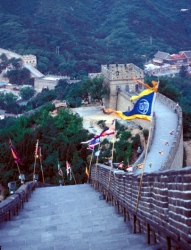 On our second day of touring we traveled by van to the Jinshanling gate of the Great Wall. I was happy to visit that section of wall because it is not as commercialized an area as several others. Instead of a cable car to ascend the wall we trekked up the steep steps which is no mean feat. The stairs are not uniform, some very far apart but others close together, some very narrow and some quite wide. The heavy iron railing along one side certainly helped me reach a point where I could look at the many miles of wall visible in each direction. To view the wall from such a vantage point was quite incredible and to imagine the astronauts observing it from space was quite unbelievable.
On our second day of touring we traveled by van to the Jinshanling gate of the Great Wall. I was happy to visit that section of wall because it is not as commercialized an area as several others. Instead of a cable car to ascend the wall we trekked up the steep steps which is no mean feat. The stairs are not uniform, some very far apart but others close together, some very narrow and some quite wide. The heavy iron railing along one side certainly helped me reach a point where I could look at the many miles of wall visible in each direction. To view the wall from such a vantage point was quite incredible and to imagine the astronauts observing it from space was quite unbelievable.
From the Great Wall we drove to the Ming Tombs where most of the emperors of the Ming Dynasty were buried between 1368 and 1644. Before entering the tombs we looked at interesting museum displays of treasures from the dynasties. We then climbed down one hundred steps to reach one of the two tombs, which are open to the public. (Afterwards, as I ascended the stairs I promised myself that I'd be sure to get in shape before my next vacation.) As we walked along the Spirit Way the setting sun cast a mystical glow on the larger than life sized stone carvings of animals and emperors which line the walk.
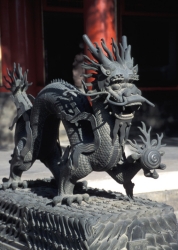 That night we feasted on the renowned Peking Duck in the elegant Hotel Kun Lun. With much ceremony our waiter carved up the duck at our table. He served us small thin pancakes onto which he spooned sauce, vegetables and duck morsels mixed with bits of crispy skin accompanied by a rice wine which only tasted decent after the third glass. Instead of wine some members of our party opted for Chinese beer. It is served from larger bottles than in the western world and thus a bottle is shared.
That night we feasted on the renowned Peking Duck in the elegant Hotel Kun Lun. With much ceremony our waiter carved up the duck at our table. He served us small thin pancakes onto which he spooned sauce, vegetables and duck morsels mixed with bits of crispy skin accompanied by a rice wine which only tasted decent after the third glass. Instead of wine some members of our party opted for Chinese beer. It is served from larger bottles than in the western world and thus a bottle is shared.
After two days of guided sightseeing we decided to spend a day venturing out on our own. Befor leaving the hotel we had the concierge write our hotel's name on a card in Chinese characters. That way, we could give it to a taxi driver if we should get lost. Since our hotel was centrally located we chose to walk to the nearby winding Silk Road. Gone are the days when the merchants sold real silks to the Chinese people! Now the market caters to tourists. None the less, it was fun to browse the rows of stalls selling cashmere sweaters, handbags, luggage, "North Face" jackets, quilts, scarves, cloisonné and almost anything else one could wish for. The prices were so cheap but I'm rather jaded so bought only a few trinkets rather than be disappointed with goods that didn't live up to my expectations. At each booth we were greeted with smiles and sales people eager to practice their limited English. When I indicated to one stall keeper that I wasn't interested in an item after she'd told me the price she explained that I must then suggest another price, back and forth until I bought the article - an amusing lesson in bargaining. The experience was fun and we enjoyed the morning immensely.
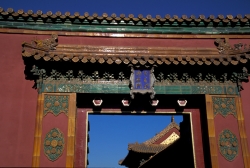 After a quick lunch we walked down the street to the Friendship Store which is operated by the Chinese government. It is truly a treasure trove of authentic Chinese arts and crafts. It has many floors and departments. As I gazed at the wonderful treasures I felt I was touring a museum. The large handmade pure silk carpets were gorgeous, as was the carved and semi-precious gemstone inlaid furniture. Beautifully patterned silk fabrics were available in quality rarely seen. I loved the department selling toys and was enthralled with the painted silk-like fabric kites. There were birds, butterflies and fish in every rainbow hue, truly so beautiful that I couldn't resist buying. I paid for my purchases and waited while they were packaged. Even the boxes were works of art! Our final stop of the day was at a department store, bustling and crowded. I was keen to find a cashmere throw like those I'd seen in America. And the one I found was perfect, a cream, soft, luxurious work of art, costing only a fourth of its price at home.
After a quick lunch we walked down the street to the Friendship Store which is operated by the Chinese government. It is truly a treasure trove of authentic Chinese arts and crafts. It has many floors and departments. As I gazed at the wonderful treasures I felt I was touring a museum. The large handmade pure silk carpets were gorgeous, as was the carved and semi-precious gemstone inlaid furniture. Beautifully patterned silk fabrics were available in quality rarely seen. I loved the department selling toys and was enthralled with the painted silk-like fabric kites. There were birds, butterflies and fish in every rainbow hue, truly so beautiful that I couldn't resist buying. I paid for my purchases and waited while they were packaged. Even the boxes were works of art! Our final stop of the day was at a department store, bustling and crowded. I was keen to find a cashmere throw like those I'd seen in America. And the one I found was perfect, a cream, soft, luxurious work of art, costing only a fourth of its price at home.
Through contacts in North America we booked a private guide for another two days of sight seeing. Mack was a Ph.D. student who had never been outside China. His English was perfect so I could hardly believe that he had not studied in an English speaking country. He loved China and shared that love with us, making our travel experience all the richer. Our touring with him was all done on public transportation, large buses, small buses, subway and taxi. At 5'8" I found that these modes of transportation did not suit my size. They were built for miniature people. Despite a bit of a backache, I survived!
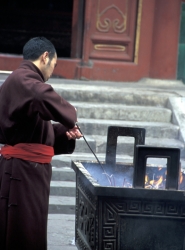 With Mack we saw the Temple of Heaven. It was a foggy morning and the mist gave the temple complex an almost mystical appearance. In sharp contrast with the spiritual qualities of the temple, many people whose faces were covered with surgical masks busily swept the grounds with their twig brooms. We also visited the interesting Lama Temple where we watched monks and Chinese citizens light incense in their rituals of worship. At noon we stopped at a restaurant for "hot pot' where you are provided the ingredients and cook them yourself in boiling broth in a container called a Mongolian hot pot. We certainly were glad to have Mack to order for us. He chose well and our meal was so delicious. Following lunch we wandered through the hutongs, ancient narrow streets where the people live. There we saw bicycle trucks making deliveries. A group of men sat at a stone table playing checkers. On one corner there was a stall selling tasty looking hot cooked chicken on bamboo skewers. We felt very fortunate to have such a terrific guide to show us the people's side of Beijing.
With Mack we saw the Temple of Heaven. It was a foggy morning and the mist gave the temple complex an almost mystical appearance. In sharp contrast with the spiritual qualities of the temple, many people whose faces were covered with surgical masks busily swept the grounds with their twig brooms. We also visited the interesting Lama Temple where we watched monks and Chinese citizens light incense in their rituals of worship. At noon we stopped at a restaurant for "hot pot' where you are provided the ingredients and cook them yourself in boiling broth in a container called a Mongolian hot pot. We certainly were glad to have Mack to order for us. He chose well and our meal was so delicious. Following lunch we wandered through the hutongs, ancient narrow streets where the people live. There we saw bicycle trucks making deliveries. A group of men sat at a stone table playing checkers. On one corner there was a stall selling tasty looking hot cooked chicken on bamboo skewers. We felt very fortunate to have such a terrific guide to show us the people's side of Beijing.
On our second day with Mack we took a taxi to the Summer Palace. This resort was built in the eighteenth century as a royal retreat to avoid the stifling summer temperatures in Peking (now called Beijing). The lavish long painted corridor and the elegant Marble Boat reveal a time of sumptuous excesses. In such a setting of beautiful gardens, ponds and lakes the rulers would have been remote from the toils of their subjects. During our return taxi ride to the city Mack pointed out the empty building shells along the main streets. They were, he told us, replacements for disintegrating buildings and were constructed to give Beijing a good appearance for the officials who would visit to review Beijing's Olympic bid. Money wasn't available to complete the projects so all the facades were constructed and eventually the structures would be completed.
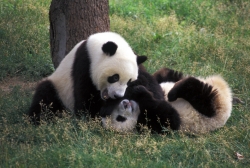 The one stop that I requested on our sightseeing expedition which Mack had difficulty understanding was a visit to the Beijing Zoo. I love bears and knew they have a very large panda habitat and breeding program. He humored me and we went to see the pandas, my first sight of real live pandas. For a delightful half hour we observed five bears, a couple cavorting playfully, oblivious to our presence. Even Mack admitted to thoroughly enjoying the diversion.
The one stop that I requested on our sightseeing expedition which Mack had difficulty understanding was a visit to the Beijing Zoo. I love bears and knew they have a very large panda habitat and breeding program. He humored me and we went to see the pandas, my first sight of real live pandas. For a delightful half hour we observed five bears, a couple cavorting playfully, oblivious to our presence. Even Mack admitted to thoroughly enjoying the diversion.
My visit to Beijing and the nearby countryside certainly exceeded my expectations. The architecture and intricate craftsmanship were amazing and I gained a new appreciation for the harmony and spiritual qualities of the Chinese culture. I loved all the Chinese people I met because they were so friendly and greeted us with happy, smiling faces. My only regrets were too few days to explore but now my interest in China is piqued and my list of places that I want to see in the country has grown. Before too long I will return.
Travel Tips
About:
King Wu was the first to declare Beijing the capital city in 1057 BC. Subsequently, the city has gone by the names of Ji, Zhongdu, Dadu, and finally Beijing when the Ming Dynasty Emperor ChengZu chose the name in 1421. Beijing was also known as Peking by the Western world before 1949. Beijing has a whole area of 16808 sq km (about 6500 sq mi), stretching 160 kilometres from east to west and over 180 kilometres north to south. She has 18 districts and counties with Dongcheng, Xicheng, Xuanwu, Chongwen, Chaoyang, Haidian, Fengtai and Shijingshan in the surburbs and Fangshan, Mengtougou, Changping, Tongxian, Shunyi, Daxing, Huairou, Miyun, Pinggu and Yianqing in the outer suburbs. Population in Beijing is about 12 million.
Where To Stay:
ZD Chinats provides a list of hotels from inexpensive and comfortable to world class luxury with prices to match.
What To Do:
A long history has left numerous famous historical sites which possess great aesthetic and cultural values. The Great Wall, a huge project begun more than 2,000 years ago, meanders through mountains and valleys for hundreds of kilometers in the region of Beijing. On the Shijing Mountain,there are more than 340 volumes of 15,000 stone tablets carved with Buddhist scriptures. The big Yongle Bell, cast at one go with over 230,000 characters on it , weighs 46.5 tons and shows the exquisite casting technology of ancient China. The Forbidden City, the largest ancient architectural complex extant today, is splendid crystallization of ancient Chinese architectural art. Walking in the city, one may find many places worth a second visit. These include mansions, gardens , gate towers , temples, former residences of celebrities and places where many historical events took place.
Climate:
Situated in the northeastern part of China at an elevation of 43.5m above sea level, the climate in Beijing is of the continental type, with cold and dry winters and hot summers. January is the coldest month (-4 Celsius), while July the warmest (26 Celsius).
The article was originally published at: 21st Century Adventures
Sunday, July 6, 2008
Tourist presentations, what to say and how to say it!
 When working in the tourism sector you could end up working for the Tourist Board and giving presentations about the area, country where you live so as to present that area to people who know little or nothing about it. So as to make my students acquainted with the process of preparing a presentation and the different stages it involves: research, compiling information, selecting pictures, music, introducing audio, giving it format, etc. This year as a final assignment I asked my students to prepare a presentation about Japan, a country they hardly knew anything about. They had to prepare a powerpoint presentation about one famous Japanese city. In the presentation, they were asked to focus on what to do in that city/town, tourist attractions, traditions, curiosities, etc.
When working in the tourism sector you could end up working for the Tourist Board and giving presentations about the area, country where you live so as to present that area to people who know little or nothing about it. So as to make my students acquainted with the process of preparing a presentation and the different stages it involves: research, compiling information, selecting pictures, music, introducing audio, giving it format, etc. This year as a final assignment I asked my students to prepare a presentation about Japan, a country they hardly knew anything about. They had to prepare a powerpoint presentation about one famous Japanese city. In the presentation, they were asked to focus on what to do in that city/town, tourist attractions, traditions, curiosities, etc. Here I include just one example by one of my students from the Andalusian e-learning Campus called Luna Meschiari. Luna, thanks for letting me post your work!
Sunday, June 22, 2008
Do you know the basics about air travel?
VideoJug: Basic Air Travel
Saturday, June 14, 2008
Beautiful Libraries Around The World
Every single one of us has a place they go to feel relaxed, to feel that special magic. Some travelers focus only on medieval castles, others prefer abandoned factories or haunted houses... I must admit that there is something special about the stillnes and tranquility of silence in libraries. Every shelf filled with a story, a tale to be told, a secret to be uncovered. Todays blog post is devoted to those special many-hundred-year-old buildings. Beautiful Libraries.
An there's an excerpt from the Curious Expeditions blog:
We had a chance to see just such a library on our recent visit to Prague. Tucked away on the top of a hill in Prague is the Strahov Monestary, the second oldest monastery in Prague. Inside, divided into two major halls, is a breathtaking library. The amazing Theological Hall contains 18,000 religious texts, and the grand Philosophical Hall has over 42,000 ancient philosophical texts. Both are stunningly gorgeous. Strahov also contains a beautiful cabinet of curiosities, including bits of a Dodo bird, a large 18th century electrostatic device, numerous wonderfully old ocean specimens, and for unclear reasons many glass cases full of waxen fruit. Our delight was manifest.
Shocked into a library induced euphoria, Curious Expeditions has attempted to gather together the world’s most beautiful libraries for you starting with our own pictures of Strahov. We hope you enjoy them as much as we do.
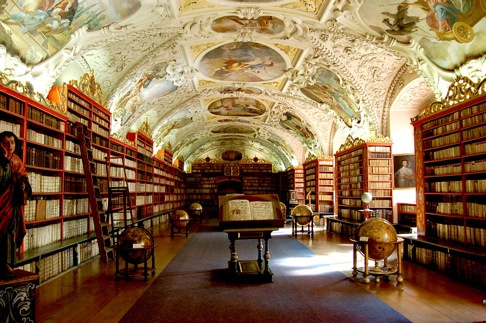 Strahov Theological Hall - Original Baroque Cabinet |
 Strahov Theological Hall; Statue of John the Evangelist Holding a Book |

 Angelica Library, Rome, Italy |
 Herzog August Library, Wolfenbüttel, Germany |
 Beatus Rhenanus Library, Basel, Switzerland |
 Bernadotte Library, Stockholm Sweden |
 Biblioteca Angelica, Rome, Italy |
 Biblioteca Di Bella Arti, Milan, Italy |
 Biblioteca do Palacio e Convento de Mafra I, Lisbon Coast, Portugal |
 Biblioteca do Palàcio Nacional da Ajuda Lisboa III, Lisbon, Portugal |
 Biblioteca Geral University of Coimbra, Coimbra, Portugal |
 Biblioteca Palafoxiana, Puebla, Mexico |

Bibliotecha de la Real Academia De La Lengua, Madrid, Spain

Real Gabinete Portugues De Leitura Rio De Janeiro, Brazil (Possibly the most beautiful library of them all.)

Rennie Mackintosh Library, Glasgow School of Art, Scotland
Saturday, June 7, 2008
Low cost airlines, is everything for sale?
Sunday, June 1, 2008
Complaining practice
Monday, May 26, 2008
Top Ten Honeymoon Destinations
Consider this an inspiration list – only a drop in the ocean of the honeymoon destinations you can explore. From more relaxed beach-centred honeymoons to those involving bustling cities or remote expeditions, speak to your personal Travel Counsellor for advice on how and where to book.
1. DUBAI HONEYMOON
Where better to spoil your loved one than in the shopping epicentre of the world? From the rich colours and scents of the souks, to the luxury of the large shopping malls, a belated wedding present must surely be on the cards.
Take your time to relax poolside or on the beach and then enjoy some of the finest cuisines in the world whilst the skyline changes around you.
Described as the ‘pearl of the Caribbean’, Barbados is a lovers’ delight. Colourful nightlife and friendly people, glorious beaches and fun-filled attractions ensure that no-one who graces these shores will ever be disappointed.
Almost year-round sunshine provides a welcome relief for winter honeymooners and the stunning backdrop will keep them coming back for more long after they have left.
Playground of the rich and famous, Mauritius has long been a top class destination, for honeymooners in particular.
Stunning beaches, luxury resorts, deep blue lagoons…the list is endless. A tropical paradise sitting afloat in the sea, this island will delight newlyweds the world over.
Taste the local cuisine and watch displays of traditional dancing before slipping to the bar for a nightcap.
Long sandy beaches fringed by overhanging palm trees, stunning coral reefs and mysterious lagoons. The whole picture evokes an image of romance, of sunbathing and swimming, of cocktails and beachside dining.
If serenity and beauty are the most important factors for your honeymoon destination, you have hit the jackpot here.
Vibrant, exotic and ethnically diverse are just a few phrases that are used to describe Malaysia. The gorgeous beaches of the coast and the lush vegetation of the rainforests, combined with first class luxury ensures that honeymooners are well looked after.
Surf, shopping, sand and sea can all be found in different areas of this fabulous country.
With decadent top class resorts offering sumptuous honeymoon suites, you can rest assured you will be in the lap of luxury in the Seychelles.
Catering toward the romance of the newly married, the privacy and seclusion of the islands’ many hotels ensures total rest and relaxation, as well as the endless possibilities of dining on the beach or indulging in a spot of pampering at the spa.
7. HAWAII HONEYMOON
With dazzling sunsets, glorious beaches and intimate dinners in which to share, it is easy to see why Hawaii is a favourite honeymoon destination.
Embracing traditions such as midnight picnics, sunset cruises and couples massage in the spa, honeymooners are made to feel extremely welcome in every sense of the word on each of these beautiful islands.
Take a romantic walk along the beach or through the orchids to truly experience Hawaii.
White, sandy beaches, sparkling waterfalls and lush vegetation are just a few of the highlights of this fantastic island.
Relax to the sounds of reggae music whilst you sip cocktails around the pool. Let the natural beauty of the island take your breath away as you marvel at the mountainous landscape.
Indulge in a tot of rum and don’t forget to bring some home for your friends.
A tropical island paradise, Fiji is bursting with jungle waterfalls, blooming orchids and palm-fringed beaches that are guaranteed to melt the heart of even the most cold-hearted of visitors.
Infamous for its great surfing, Fiji is a veritable feast of water sports and aquatic wildlife, along with a thriving nightlife and dining scene.
The pace of life is relaxed here, so take your time to enjoy it.
Frenetic nightlife, an abundance of cultural attractions and in the middle of it all, a more tranquil green haven known as Central park.
Of course, this is New York, a lesser known honeymoon destination, who caters to the city crowd and those who like to enjoy their entertainment at super speed.
But romance can flourish in the most unlikely of places, and New York is just one of those destinations.
LINKS:Travel Counsellors UK Website - more about the top 10 Honeymoon Destinations!
Sunday, May 25, 2008
Where in the world?

If you want to concentrate on your European geography knowledge, you can do this QUIZ.
Thanks to Ana Concejero for letting me know about the World Traveller IQ game.
Travelling in Europe
 There is an interesting website that gathers all the information you need to travel within Europe. Have a look!
There is an interesting website that gathers all the information you need to travel within Europe. Have a look!Remember Europe is a continent with thousands of years of history and a rich cultural heritage! So there is much for the traveller to discover and explore and all made much easier thanks to the European Union (EU). You can cross many borders within the EU without being checked and the euro makes it easier to move from country to country. If you drive, your driving licence and motor insurance policy issued in one EU country are valid in all the others. And you can use your mobile phone everywhere.
Thursday, May 15, 2008
Working in Europe
There are many different models of CVs but you should definitely start using the Europass Curriculum Vitae. Have a look at different models of Europass CVs and then write your own Europass CV online.








